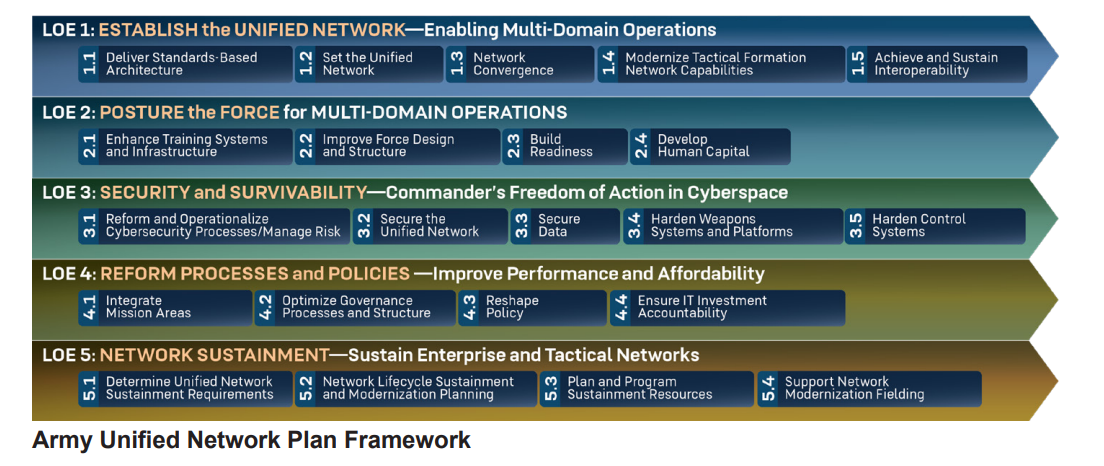
Insight by Verizon
Army kicks Unified Network Operations effort into gear
The Army Unified Network Plan outlines the high level journey the service began last year and will pick up steam in 2024 when the Unified Network Operations (UNO)...
Maj. Todd Donaldson, a communications and network officer for the 2nd Armored Brigade Combat Team, 3rd Infantry Division in the Army, has a simple request when it comes to network modernization.
“At the operational level, I just want to be able to see my network, both the upper tactical and the lower tactical, especially as those mesh radios have been integrated into the formations,” Donaldson said at the recent Technology Exchange Meeting (TEMS) hosted in Philadelphia by the Army’s Program Executive Office Command, Control, Communications-Tactical (PEO C3T).
“I want to be able to see what’s on the network, what’s not on the network,” he continued. “If something starts to drift, I want to be able to pull it back in. I want to be able to see how much data we’re using and how congested that network might be at that time. I want to see how many users we have up on it as we continue to expand with our mesh network, and I’m going to have a lot of radios on that network. I need to be able to see it, and sometimes it feels like we’re very much flying blind. But to be able to see that would really help me enable and facilitate that capability for my commander.”
Donaldson’s summation of the Army’s straightforward desire is what’s driving the Unified Network Operations (UNO) strategy over the next six years.
The Army Unified Network Plan outlines the high-level journey the service began last year and that will pick up steam in 2024 when UNO becomes a program of record.
“The Army Unified Network employs a common operating environment, services infrastructure and transport layer, as well as unified network operations and cyber defensive capabilities. It enables intel at all levels of network classifications required to conduct multi-domain operations,” the strategy stated.
The plan details five lines of effort (LOE) that will shape UNO and lead the Army toward multidomain operations by 2028:
Source: Army, “Army Unified Network Plan,” 2021
Army Chief Information Officer Raj Iyer said at the event that the strategy is turning the service’s network modernization approach on its head. Instead of putting the network above all, the data and the fabric that underlies the data is driving the service’s approach, Iyer said.
“How we’re architecting the unified network for the future really is to start with the data first, and then we put the zero trust cyber architecture on top of that because, again, that cannot be an afterthought,” he said. “So once you do those two core pieces, the rest of the network now starts to flow, quite frankly, a little easier because now we’ve made those decisions on what level of data we need — where, when and how much — and how much of that needs to be in a disconnected mode in a digital environment versus persistent connectivity back in some sense.”
Iyer summed up the projected end state of UNO succinctly: “At the end of the day, the network has to be scalable, resilient, secure and survivable because we know with a near-peer adversary in the future, one of the first things that will happen and, we validated this most recently in Europe, is electromagnetic warfare, and the first thing that will happen is the jamming of your network. So how extensive do you want this to be? How can you get to this mesh architecture, where you don’t have a single point of failure in the architecture? Because today, that’s how we operate?”
Acquisition strategy coming into focus
The October 2021 strategy was the first step, but now the Army is moving into the acquisition and implementation stages of the effort.
Making UNO a program of record in 2024 will ensure the Army funds and tracks its progress.
The acquisition piece is starting to coalesce too, with an initial request for information from the Army’s Program Executive Office Enterprise Information Systems (PEO EIS) this summer and then a draft request for proposal in early fiscal 2023. The Army expects to release the first of several expected solicitations for UNO by June 2023, with an award by December 2023.
“Right now, we’re thinking about merging upper and lower tiers into the same contract and maybe figure out is there a way where we can get after solutions that support IT support both within a command post and between command posts?” said Matt Maier, the Army’s program manager for interoperability, integration and services within PEO C3T. “The question is, how can we bridge that enterprise identity and access management capability down into the tactical space? We need to do that by merging and collapsing of capabilities. But it’s likely to be a different type of a vendor approach for us, and we’ll probably use some different vendors’ capabilities. So, that may end up becoming its own separate contract vehicle.”
No matter how many requests for proposals end up coming out, the end result has to come back to Donaldson’s request to simplify and reduce the burden on soldiers and commanders, Maier said.
“We want to reduce the cognitive load for them. We want to reduce the time it takes for them to complete tasks. We want to provide that single pane of glass, and we want to provide that common user interface. We want it to be simple, easy and as intuitive as possible to use,” he said. “I think that capabilities to apply both at the tactical space and the enterprise space is going to require close collaboration between multiple program managers. We’re going to have to develop some kind of standards that everyone would have to conform to so that we can merge them together. We’ll probably be developing an application program interface. We’ll definitely be producing some API middleware for you to use, which will allow you to build capabilities that can fall within this construct and conform to the single pane of glass graphic user interface that we want to provide to soldiers.”
Requirements under review
Sometimes industry partners will design technology for a radio, but then have to scale it across the entire enterprise to work at regional hubs and beyond. Maier noted that the software will have to be flexible enough to take on new and emerging technology when needed and available.
“The six requirements definition packages will come out in priority order. The very first one that will be signed by the Army Requirements Oversight Council this year is for the lower-tactical tier, and that happens in fourth quarter. That’s our focus in the near term,” he said. “We can focus on what planning, management, configuration, initialization, control and monitoring tools exist today and where can we gain some opportunities for optimization. What are the building blocks that we can set the stage with for radio management, for example? Then, we can start to migrate those capabilities up into the upper-tactical tier and merge and replace older capabilities as newer capabilities come online. I think the reason that we’re starting in the lower-tactical tier and upper-tactical airspace is because capabilities there are not very well integrated, like they are in the enterprise space.”
The lack of integration and duplicative, noncomplementary capabilities is a driving factor of UNO as well.
Col. Christian Haffey, director of the Cyber Capability Development Integration Directorate at the Army’s Cyber Center of Excellence and Future Concepts Center, said the enterprise network currently has hundreds of tools and capabilities that are not integrated, which are complex and costing the Army a lot to sustain.
“We’re looking to drive down the number of tools and the sustainment costs. It’s not that we’re trying to lower our investments in the network. It’s just we have to continually assess our budget, and we have to look across all areas,” Haffey said. “As we’re investing and equipping new tools, we also have to then forecast what we have to invest into sustainment and what we have to invest in training of individuals. There’s a tail of costs that we have to continue to consider.”
Network as a weapon
Part of the UNO strategy also is to identify and mitigate capability gaps on the network and in services that support the network, he said.
The long-term goal for this entire UNO initiative is to change the way the Army thinks about and uses its network.
“UNO is going to enable the Army to use its network as a weapon system. So rather than fighting against the network, as you all have done as you move from one area of responsibility to another AOR, you really fought our own network because of our own policies of our own tools,” Haffey said. “The unified network is to change that mindset, and it give us an end-to-end visibility to be able to sense, control and visualize devices and users on our network. UNO will provide that tailorable and scalable DoD Information Network operations that we will be able to tailor for that user or for that warfighter, as he or she moves across the battlefield or as he or she moves from the continental United State to Joint Base Lewis-McChord and into the Indo Pacific AOR.”
That’s the ultimate deliverable, Haffey said: “They’re not fighting against the network.”
Copyright © 2025 Federal News Network. All rights reserved. This website is not intended for users located within the European Economic Area.
Related Stories






